2. 工业聚集区污染控制与生态修复教育部重点实验室, 广州 510006;
3. 佛山市化尔铵生物科技有限公司, 佛山 528300
2. Key Laboratory of Pollution Control and Ecosystem Restoration in Industry Cluster, Guangzhou 510006, China;
3. Huaan Biotech Co., Ltd., Foshan 528300, China
近年来, 新型脱氮工艺厌氧氨氧化技术因其具有许多优点而被广泛研究[1~4], 该反应要求氨氮与亚硝酸盐氮的量浓度比为1:1.32[5], 而实际废水中, 亚硝酸盐氮难以稳定积累, 因此实现稳定亚硝化是这一技术的关键所在.有研究表明, 通过高温[6]、低溶解氧(DO)[7]、游离氨(FA)和游离亚硝酸(FNA)[8]等均可实现亚硝酸盐氮的积累.但高温(30~35℃)条件会消耗过多的能量[9]; 低溶解氧操作过程难以控制[10], 并且氨氧化菌(AOB)活性也会有所降低, 影响亚硝化的速率[11].而控制FA浓度已经被多数学者用来实现亚硝化[12, 13], 有氧条件下, 氨氮会被AOB消耗, FA的浓度会降低, 并逐渐失去对亚硝酸盐氧化菌(NOB)的抑制作用, 因此寻找一种有效控制FA浓度来实现稳定亚硝化的方法十分有意义.沸石因其良好的吸附能力可以有效去除水中的氨氮[14], 有研究发现填充沸石填料的生物滤池可以有效控制FA浓度, 利用其对AOB和NOB的不同抑制作用实现稳定亚硝化[15].但鲜有通过沸石序批式反应器(zeolite sequencing batch reactor, ZSBR)控制适宜的FA浓度并实现稳定亚硝化的研究.
因此, 本试验采用ZSBR处理模拟氨氮废水, 在实现稳定亚硝化基础上探究其在不同碱度条件下亚硝化的效果, 并分析其中微生物群落的变化, 以期为其在氨氮废水亚硝化处理的工程应用上提供理论参考.
1 材料与方法 1.1 试验流程和反应装置本试验使用的反应器由有机玻璃制成, 包括带有下漏斗的柱体和曝气头两部分(图 1), 长15 cm, 宽15 cm, 高45 cm, 有效容积9 L, 投加30 g·L-1 80~200目的天然沸石作填料, 具体参数见表 1.
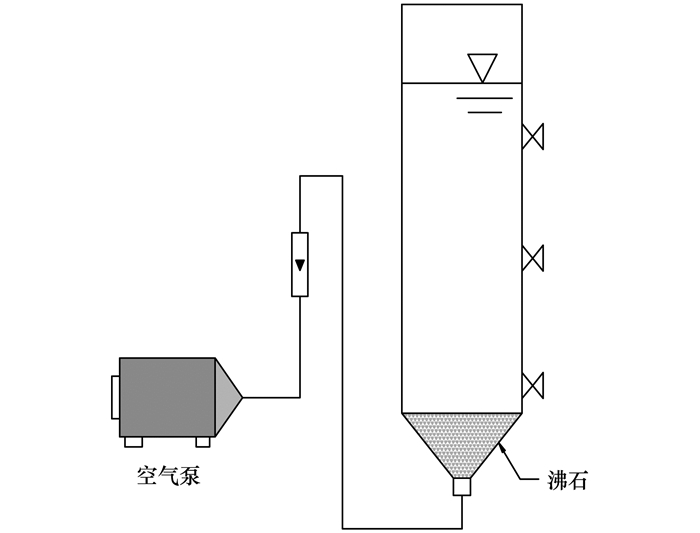
|
图 1 ZSBR装置示意 Fig. 1 Schematic diagram of the ZSBR |
|
|
表 1 天然沸石的物理特性 Table 1 Characteristics of natural zeolite |
1.2 接种污泥
接种污泥取自实验室培养成熟的硝化污泥, 污泥质量浓度MLVSS为3 500 mg·L-1.
1.3 试验进水本试验进水为人工配制的模拟废水, 氯化铵作为氮源, 碳酸氢钠提供碱度, 同时添加氯化钙、磷酸二氢钾、硫酸镁等为微生物生长提供营养元素, 参照Wei等[16]的研究成果添加微量元素, 不添加有机碳源, 试验进水氨氮300~500mg·L-1, 碱度(以CaCO3计)2 000~4 000 mg·L-1.
1.4 分析方法氨氮、亚硝酸盐氮和硝酸盐氮的监测使用文献[17]推荐的标准监测方法; pH、溶解氧分别使用PHS-3C型pH计和HQ30d溶解氧仪; 微生物群落结构使用高通量基因测序技术.
氨氮转化率、亚硝酸盐氮积累率、亚硝酸盐氮产率参考文献[18]的公式进行计算; FA浓度(mg·L-1)根据Anthonisen等[19]提出的公式(1)进行计算.

|
(1) |
ZSBR反应器运行周期为6h, 其中进水、反应、沉淀、排水时间分别为15、300、30和15 min; 每次排水体积为反应器有效容积的一半4.5 L, 1 d运行两个周期.
本试验共分为两个阶段进行, 不同阶段运行条件见表 2.第1阶段为亚硝化阶段, 旨在快速实现稳定的亚硝化, 进水氨氮300~500 mg·L-1, 碱度(以CaCO3计)2400~4 000 mg·L-1; 第2阶段, 旨在探究ZSBR在不同投加碱度条件下的亚硝化性能, 进水氨氮500 mg·L-1, 碱度(以CaCO3计)2 000、2 500、3 000和3 500 mg·L-1.整个试验过程中, 系统温度为室温条件(25℃±1℃), 曝气量控制在0.3 m3·h-1.
|
|
表 2 ZSBR在不同阶段下的运行条件 Table 2 Detailed operational conditions during different stages of the ZSBR |
2 结果与讨论 2.1 ZSBR亚硝化的启动
启动亚硝化系统共历时25个周期(13 d), 试验结果见图 2.启动阶段共经历两个阶段:第1~10周期, 进水氨氮300mg·L-1; 第11~25周期, 进水氨氮500mg·L-1.启动阶段, 系统中平均氨氮转化率为58.8%;随着运行周期的推移, 出水亚硝酸盐氮浓度逐渐变大; 而出水硝酸盐氮浓度始终维持在一个较低水平, 平均仅有27.12mg·L-1.亚硝酸盐氮积累率大于50.0%是短程硝化的标志[20]. 图 2显示, 在第1个周期, 系统中亚硝酸盐氮积累率为56.8%, 此时可以认为ZSBR已经实现了短程硝化.到第2个运行周期结束时, 系统中亚硝酸盐氮积累率就已经达到83.2%.从第11个周期开始亚硝酸盐氮积累率就始终维持在90.0%以上, 平均水平为92.9%, 这说明ZSBR系统已经成功实现了稳定的亚硝化过程, 此时氨氧化细菌(AOB)已经被大量富集, 而亚硝酸盐氧化菌(NOB)则被大量淘洗[21].
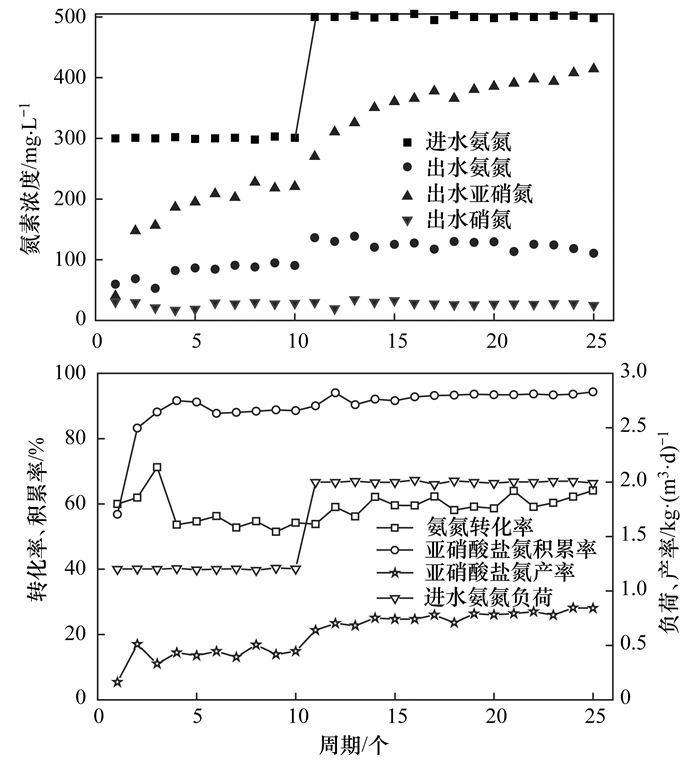
|
图 2 ZSBR启动期间运行状况 Fig. 2 Operational performance during the start-up period of the ZSBR |
在低温(11~16℃)条件下, Gu等[22]基于对pH和曝气频率的实时控制, 历时40 d, 亚硝酸盐氮积累率从19.8%升高至90.0%;李冬等[23]在高低浓度氨氮废水交替进水以及低溶解氧(0.15~0.40mg·L-1)的条件下, 历时33个周期(20 d)成功实现亚硝化, 亚硝化积累率基本维持在85.0%左右.而在本试验中, 仅仅经过25个周期(13 d)的运行, 就成功实现了稳定的亚硝化过程, 启动时间大大缩短.由此可见, 加入沸石有助于反应器的快速启动.
2.2 碱度对ZSBR亚硝化的影响亚硝化过程是一个产酸的过程, 其反应式如下:

|
(2) |
在亚硝化过程中, 氨氮在AOB的作用下被氧化成亚硝酸盐氮, 同时产生氢离子[24].从反应式(2)中可以看到, 氧化1 mol的铵根离子会生成2 mol的氢离子, 这会导致反应过程中系统pH的下降, 因此需要在系统中添加一定的碱度使得反应可以正常进行.本试验使用碳酸氢钠提供碱度.当其浓度过高时, 高浓度的钠离子会加速沸石解吸[25], 同时高浓度的碳酸氢根也会使系统中的pH过高; 当其浓度过低时, 低浓度的碳酸氢根又不足以对硝化反应所生成的酸起到足够的缓冲作用.因此加入适当的碱度维持系统中的pH十分重要.
不同碱度条件下ZSBR运行的试验结果如图 3.碱度3 500 mg·L-1条件下, 系统平均氨氮转化率为35.9%, 在第21 d和22 d, 系统的氨氮转化率出现了大幅度的下降, 仅有24.3%和19.1%;碱度3 000 mg·L-1的条件下, 系统平均氨氮转化率为33.4%, 在第28 d, 系统氨氮转化率出现该条件下的最低值, 仅有25.5%;碱度2 500 mg·L-1条件下, 系统平均氨氮转化率为66.7%, 氨氮转化率在第32 d之后一直维持在较高的水平, 在运行至第37 d时达到最高, 为75.1%;碱度2 000 mg·L-1的条件下, 系统平均氨氮转化率虽然有38.1%, 但是在运行周期里, 系统氨氮转化率呈现出十分明显的下降趋势, 到第49 d时, 系统氨氮转化率已经下降到11.9%.可以明显发现在其他条件保持一致的条件下, 系统碱度2 500 mg·L-1时, 系统具有较好的氨氮转化率, 说明在此条件下, 系统中AOB具有较高的活性.同时在不同碱度条件下, 亚硝酸盐氮积累率都维持在较高水平, 最高时可达到99.2%, 最低时也有95.8%, 说明不同投加碱度对系统的亚硝化性能影响不大, ZSBR系统具有较高的稳定性.通过比较不同碱度条件下亚硝酸盐氮产率发现, 与其他3个碱度条件相比, 当系统碱度为2 500 mg·L-1时, 亚硝酸盐氮产率可高达0.86kg·(m3·d)-1, 平均亚硝酸盐氮产率为0.74 kg·(m3·d)-1.因此对于ZSBR, 最适的碱度条件为2 500mg·L-1, 此时氨氮:碱度为1:5.
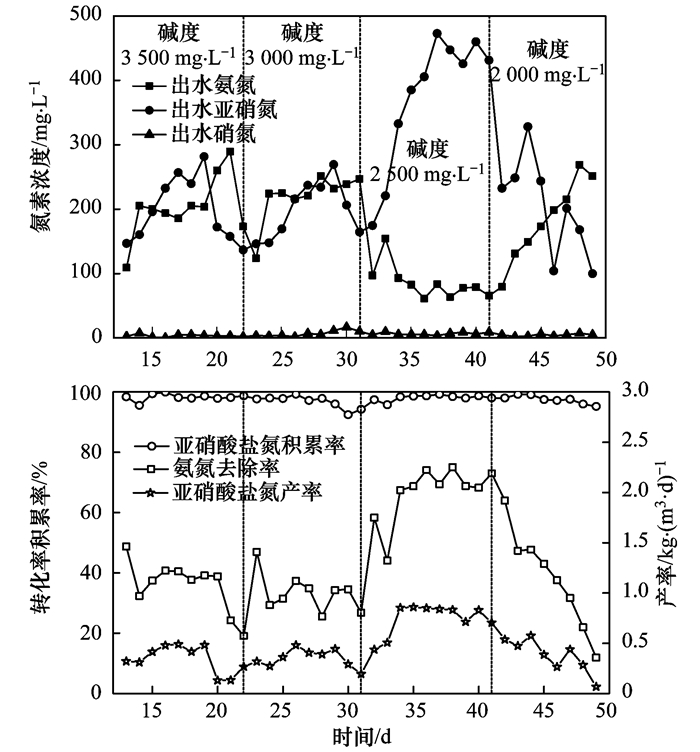
|
图 3 不同碱度条件下ZSBR的运行状况 Fig. 3 Operational performance of the ZSBR under the different alkalinity conditions |
与硝化反应有关的两类细菌分别为AOB和NOB, 而亚硝化的成功实现就是一个选择性富集AOB抑制NOB的过程.在本试验中, 系统温度控制在室温下(25℃±1℃), 溶解氧浓度为4.0~6.0mg·L-1, 这两者显然不符合启动亚硝化的最适条件.本试验中所使用天然沸石的平均吸附孔径为3.30 nm, 氨气和铵根离子的平均孔径分别为0.14 nm和0.54 nm[26], 说明这两种物质可以进入沸石孔道而被吸附.在ZSBR中, 沸石可以有效控制系统中的氨氮浓度.游离氨受到温度、pH和氨氮浓度的影响, 因此控制系统中的氨氮浓度可以有效控制游离氨的浓度, 使得FA浓度处于对NOB的抑制程度远大于对AOB的抑制程度的范围内, 以此可以使反应器中的AOB得到富集, 而NOB在抑制作用下不断被淘洗出反应器. 图 4显示在第二阶段运行过程中, 每一周期反应结束后系统中FA浓度都大于其对NOB产生抑制的阈值(0.1~1.0mg·L-1)[19], NOB的活性受到抑制, 这与整个运行过程中亚硝酸盐氮积累率都维持在较高水平, 没有发生较大波动有关.同时, 可以发现系统碱度为2 500 mg·L-1时, 系统中的FA浓度范围在1.60~14.37mg·L-1, 平均FA浓度为5.50mg·L-1; 在其他碱度运行条件下, 系统中FA浓度最高达到91.05mg·L-1, 并且始终处于一个较高的水平.而FA对AOB产生抑制的阈值为10~150 mg·L-1[19], 因此在碱度2 500 mg·L-1条件下AOB受到的抑制程度要远小于其他条件下受到的抑制程度, 这与在该条件下系统具有较高的氨氮转化率和亚硝酸盐氮产率相一致.因此, 在本试验中FA的抑制是ZSBR实现亚硝化的主要原因.
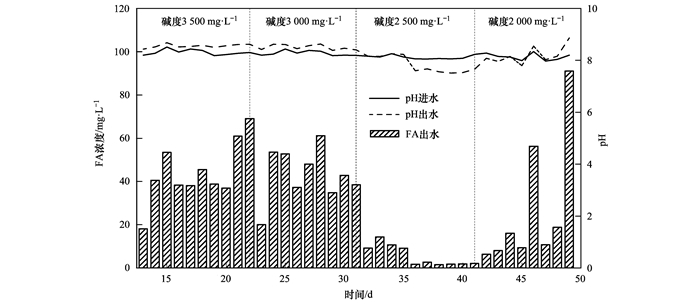
|
图 4 不同碱度条件下ZSBR中游离氨和pH的变化 Fig. 4 Variations of FA and pH in the ZSBR under the different alkalinity conditions |
对ZSBR中微生物群落组成以及功能进行研究, 可以了解ZSBR处理工艺的机制, 同时也可以预测反应器处理能力的变化, 为反应器的运行和改进提供理论依据.本试验通过对接种污泥以及不同投加碱度运行条件下ZSBR中的污泥样品进行高通量测序, 探究ZSBR的运行机制.基于16S rRNA基因序列分析从5个ZSBR污泥样品中分别获得593 OTUs(操作分类单元)和1 041 OTUs, 为分析ZSBR实现亚硝化以及在不同碱度运行条件下的生物机制, 对所得序列分别在门、纲和属水平上进行分类, 结果如图 5所示.发现seed(接种污泥)、N/A7(碱度3 500 mg·L-1)、N/A6(碱度3 000 mg·L-1)、N/A5(碱度2 500 mg·L-1)和N/A4(碱度2 000 mg·L-1)这5个样品中微生物群落区别明显.在门水平分类, 接种污泥中优势菌门为Bacteroidetes(36.4%)、Proteobacteria(31.5%); N/A7中优势菌门为Proteobacteria(48.4%)和Bacteroidetes(35.7%); N/A6中优势菌门为Proteobacteria(48.9%)和Bacteroidetes(33.4%); N/A5中优势菌门为Proteobacteria(57.8%)和Bacteroidetes(24.8%); N/A4中优势菌门为Proteobacteria(44.4%)和Bacteroidetes(24.6%).可以发现在ZSBR成功实现稳定亚硝化后Proteobacteria的相对丰度明显变大, 而Bacteroidetes的相对丰度明显减小, 这与杨永愿等[15]发现Proteobacteria在亚硝化过程中得到增殖相一致.同时, 在不同碱度运行条件下, 4个污泥样品中优势菌门种类相同, 差别仅仅在于各菌门含量不同. Proteobacteria在N/A5样品中的相对含量明显高于其他3个样品(N/A7、N/A6和N/A4), 这与ZSBR在碱度2 500 mg·L-1条件下具有更高的氨氮转化率相一致.进一步在纲水平进行比较发现, β-Proteobacteria在亚硝化启动后相对含量明显增加, 并且在N/A5样品中其相对含量明显高于其他3个样品(N/A7、N/A6和N/A4). Chen等[27]的试验结果也表明, 在亚硝化体系中β-Proteobacteria为优势菌纲.在属水平上硝化细菌的分类结果见表 3, 4个污泥样品中(N/A7、N/A6、N/A5和N/A4)AOB(Nitrosococcus和Nitrosomonas)的相对丰度分别为18.2%、19.5%、27.0%和15.6%, NOB(Nitrospira)相对丰度均小于0.1%, 结果表明在ZSBR的运行过程中, AOB得到了累积, 而NOB的生长受到了抑制不断被淘洗, 从而使得ZSBR实现了稳定的亚硝化.同时, 样品N/A5中AOB的相对丰度高于其他3个样品(N/A7、N/A6和N/A4), 这也说明了在碱度2 500 mg·L-1的条件下, ZSBR系统具较高的氨氮转化率.
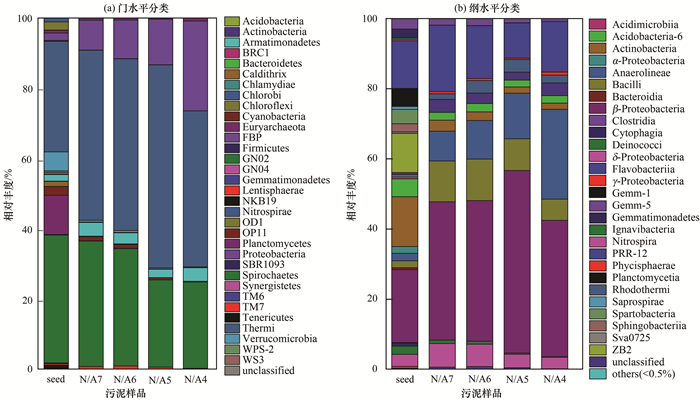
|
图 5 接种污泥与ZSBR不同碱度运行条件下污泥样品的微生物群落分析 Fig. 5 Microbial community analysis of seed sludge and the ZSBR sludge samples under different alkalinity conditions |
|
|
表 3 不同样品属水平下AOB和NOB的相对丰度1)/% Table 3 Relative abundance of AOB and NOB at the genus level for different samples/% |
3 结论
(1) 本试验采用沸石序批式反应器(ZSBR)在常温(25℃±1℃)下, 经过25个周期的运行, 反应器中氨氮转化率为64.1%, 亚硝酸盐氮积累率为94.3%, ZSBR系统成功实现快速稳定地亚硝化, 并且经此部分亚硝化转化后的含氨氮的废水, 可以作为厌氧氨氧化的进水, 进一步脱除水中的氨氮与总氮.
(2) 当进水氨氮500mg·L-1, 系统投加碱度(以CaCO3计)2 500 mg·L-1, 即氨氮:碱度为1:5时, ZSBR亚硝化效果最好, 平均氨氮转化率为66.7%, 平均亚硝酸盐氮积累率为98.1%, 平均亚硝酸盐氮产率为0.74kg·(m3·d)-1.
(3) ZSBR实现亚硝化的关键是FA对NOB的抑制作用;
(4)高通量测序结果表明, 长时间运行之后反应器中微生物群落发生显著变化, AOB被富集, NOB被抑制, ZSBR可以快速成功启动亚硝化.
| [1] | Mulder A, Van De Graaf A A, Robertson L A, et al. Anaerobic ammonium oxidation discovered in a denitrifying fluidized bed reactor[J]. FEMS Microbiology Ecology, 1995, 16(3): 177-184. DOI:10.1111/fem.1995.16.issue-3 |
| [2] | 叶建锋. 废水生物脱氮处理新技术[M]. 北京: 化学工业出版社, 2006. |
| [3] |
孙洪伟, 彭永臻, 王淑莹, 等. 厌氧氨氧化生物脱氮技术的演变、机理及研究进展[J]. 工业用水与废水, 2008, 39(1): 7-11. Sun H W, Peng Y Z, Wang S Y, et al. Evolution, mechanism and research progress of anaerobic ammonium oxidation technology for biological denitrification[J]. Industrial Water & Wastewater, 2008, 39(1): 7-11. DOI:10.3969/j.issn.1009-2455.2008.01.002 |
| [4] | Li X J, Sun S, Badgley B D, et al. Nitrogen removal by granular nitritation-anammox in an upflow membrane-aerated biofilm reactor[J]. Water Research, 2016, 94: 23-31. DOI:10.1016/j.watres.2016.02.031 |
| [5] | Strous M, Van Gerven E, Zheng P, et al. Ammonium removal from concentrated waste streams with the anaerobic ammonium oxidation (Anammox) process in different reactor configurations[J]. Water Research, 1997, 31(8): 1955-1962. DOI:10.1016/S0043-1354(97)00055-9 |
| [6] | Hellinga C, Schellen A A J C, Mulder J W, et al. The sharon process:An innovative method for nitrogen removal from ammonium-rich waste water[J]. Water Science and Technology, 1998, 37(9): 135-142. DOI:10.2166/wst.1998.0350 |
| [7] | Blackburne R, Yuan Z G, Keller J. Partial nitrification to nitrite using low dissolved oxygen concentration as the main selection factor[J]. Biodegradation, 2008, 19(2): 303-312. DOI:10.1007/s10532-007-9136-4 |
| [8] | Yao Q, Peng D C, Wang B, et al. Effect of free ammonium and free nitrous acid on the activity, aggregate morphology and extracellular polymeric substance distribution of ammonium oxidizing bacteria in partial nitrification[J]. Journal of Bioscience and Bioengineering, 2017, 124(3): 319-326. DOI:10.1016/j.jbiosc.2017.03.015 |
| [9] | Chen Z G, Wang X J, Yang Y Y, et al. Partial nitrification and denitrification of mature landfill leachate using a pilot-scale continuous activated sludge process at low dissolved oxygen[J]. Bioresource Technology, 2016, 218: 580-588. DOI:10.1016/j.biortech.2016.07.008 |
| [10] | Soliman M, Eldyasti A. Development of partial nitrification as a first step of nitrite shunt process in a sequential batch reactor (SBR) using ammonium oxidizing bacteria (AOB) controlled by mixing regime[J]. Bioresource Technology, 2016, 221: 85-95. DOI:10.1016/j.biortech.2016.09.023 |
| [11] | Yang S, Yang F L. Nitrogen removal via short-cut simultaneous nitrification and denitrification in an intermittently aerated moving bed membrane bioreactor[J]. Journal of Hazardous Materials, 2011, 195: 318-323. DOI:10.1016/j.jhazmat.2011.08.045 |
| [12] | Chung J, Shim H, Lee Y W, et al. Comparison of influence of free ammonia and dissolved oxygen on nitrite accumulation between suspended and attached cells[J]. Environmental Technology, 2005, 26(1): 21-33. DOI:10.1080/09593332608618587 |
| [13] | Sui Q W, Liu C, Zhang J Y, et al. Response of nitrite accumulation and microbial community to free ammonia and dissolved oxygen treatment of high ammonium wastewater[J]. Applied Microbiology and Biotechnology, 2016, 100(9): 4177-4187. DOI:10.1007/s00253-015-7183-z |
| [14] |
张璐, 杨忆新, 罗明生, 等. 天然沸石去除煤化工废水中氨氮的研究[J]. 工业水处理, 2018, 38(7): 46-49. Zhang L, Yang Y X, Luo M S, et al. Research on natural zeolite for the removal of ammonia nitrogen from coal chemical wastewater[J]. Industrial Water Treatment, 2018, 38(7): 46-49. |
| [15] |
杨永愿, 汪晓军, 赵爽, 等. 沸石曝气生物滤池短程硝化特性及其机制[J]. 中国环境科学, 2017, 37(12): 4518-4525. Yang Y Y, Wang X J, Zhao S, et al. Partial nitrification performance and mechanism of zeolite biological aerated filter for ammonium wastewater treatment[J]. China Environmental Science, 2017, 37(12): 4518-4525. DOI:10.3969/j.issn.1000-6923.2017.12.014 |
| [16] | Wei D, Xue X D, Yan L G, et al. Effect of influent ammonium concentration on the shift of full nitritation to partial nitrification in a sequencing batch reactor at ambient temperature[J]. Chemical Engineering Journal, 2014, 235: 19-26. DOI:10.1016/j.cej.2013.09.005 |
| [17] | 国家环境保护总局. 水和废水监测分析方法[M]. (第四版).北京: 中国环境科学出版社, 2002. |
| [18] | Chen J, Wang R X, Wang X J, et al. Response of nitritation performance and microbial community structure in sequencing biofilm batch reactors filled with different zeolite and alkalinity ratio[J]. Bioresource Technology, 2019, 273: 487-495. DOI:10.1016/j.biortech.2018.11.020 |
| [19] | Anthonisen A C, Loehr R C, Prakasam T B, et al. Inhibition of nitrification by ammonia and nitrous acid[J]. Journal Water Pollution Control Federation, 1976, 48(5): 835-852. |
| [20] | 王博.高氨氮废水亚硝化控制策略及运行特性[D].西安: 西安建筑科技大学, 2016. |
| [21] | Sinha B, Annachhatre A P. Partial nitrification-operational parameters and microorganisms involved[J]. Reviews in Environmental Science and Bio/Technology, 2007, 6(4): 285-313. DOI:10.1007/s11157-006-9116-x |
| [22] | Gu S B, Wang S Y, Yang Q, et al. Start up partial nitrification at low temperature with a real-time control strategy based on blower frequency and pH[J]. Bioresource Technology, 2012, 112: 34-41. DOI:10.1016/j.biortech.2011.12.028 |
| [23] |
李冬, 陶晓晓, 李占, 等. 常温SBR亚硝化快速启动及优化试验研究[J]. 环境科学, 2011, 32(6): 1653-1659. Li D, Tao X X, Li Z, et al. Research on the rapid start-up and optimization of parameters for nitrosation at room temperature[J]. Environmental Science, 2011, 32(6): 1653-1659. |
| [24] | Paredes D, Kuschk P, Mbwette T S A, et al. New aspects of microbial nitrogen transformations in the context of wastewater treatment-A review[J]. Engineering in Life Sciences, 2010, 7(1): 13-25. |
| [25] | Lahav O, Green M. Bioregenerated ion-exchange process:The effect of the biofilm on ion-exchange capacity and kinetics[J]. Water S. A, 2000, 26(1): 51-57. |
| [26] | 曲珍杰.超声强化人造沸石处理高浓度氨氮废水[D].南京: 南京工业大学, 2016. |
| [27] | Chen Z G, Wang X J, Chen X Z, et al. Nitrogen removal via nitritation pathway for low-strength ammonium wastewater by adsorption, biological desorption and denitrification[J]. Bioresource Technology, 2018, 267: 541-549. DOI:10.1016/j.biortech.2018.07.084 |
 2019, Vol. 40
2019, Vol. 40


